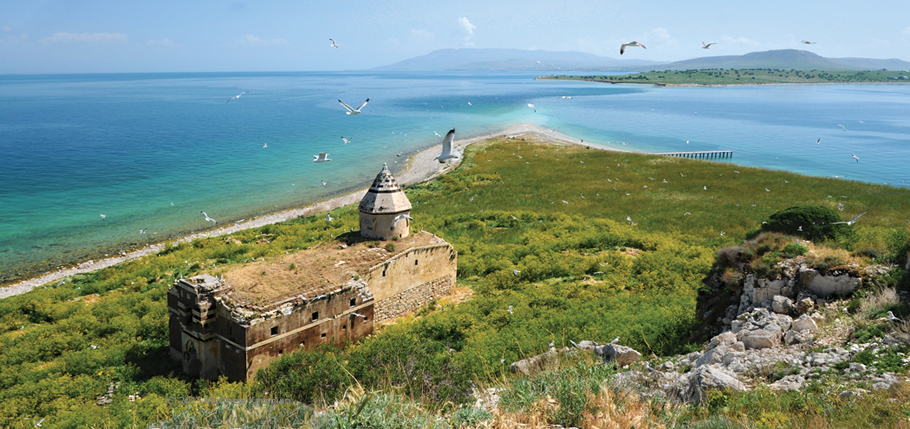Turkish Obstacles No Barrier for Karanian
August 31, 2015PASADENA, Calif.—You’re three weeks away from your first trip to Historic Armenia, flying to Istanbul aboard a Turkish airliner from Boston, and news bulletins are reporting the upheaval in the country. Any cause for alarm?
Not if you’re Matthew Karanian, a published author, and photographer whose book Historic Armenia has won its share of fan approval. Karanian focuses on Western Armenia after 100 years, giving particular notice to Ani, Kars, and the six Armenian Provinces.
He’s faced a number of obstacles during his various pilgrimages abroad.
But virtually nothing stands in his path to capture a worthy image.
“Remember that I went to Van alone in 1997 when the PKK was shooting down Turkish military helicopters. By comparison, conditions today are mostly calm, mostly everywhere,” he vividly recalls.
By all standards, Karanian and other repeat visitors wouldn’t renege on a trip planned by Armen Aroyan, a veteran tour guide and Anatolian missionary. Everyone’s safety would be Aroyan’s utmost concern and any potential risk would be taken into consideration.
A terrorist attack three weeks prior in Istanbul would result in increased security, insiders tell us.
“Nevertheless, I would advise caution near the Turkish-Syrian frontier,” Karanian adds. “And I would avoid crowds and try not to offend anyone. It’s kind of like the advice I might give to someone who was planning to visit Los Angeles.”
As to what one might anticipate upon a maiden trip to Turkey, Karanian shares some of his own insight. Over the course of six trips, experience breeds knowledge.

The church of Sourp Garabed is the last intact structure of the Armenian monastery on Ktuts Island in Lake Van. Ruins of other structures, including the remnants of monks’ cells and a cemetery, are still present. (Photo by Matthew Karanian, reprinted with permission from ‘Historic Armenia After 100 Years.’)
“Expect to be simultaneously angry and happy, angry and confused, angry yet proud,” he maintains. “The anger will diminish. With time, you might even be able to calm down enough to take some photographs and write about the place.”
Karanian added, “Don’t expect a uniform attitude from the people you meet throughout today’s Turkey. You may encounter some coolness and even mild hostility in conservative regions such as Erzerum. But warm hospitality is the norm in the region of Van.”
“Anticipate that Kurds in the rural eastern provinces will have a better understanding of Armenian history than will Turks living in the modern western region,” Karanian continued. “Don’t be surprised if everything reminds you of Armenia.”
My two trips to Eastern Armenia were both dynamic experiences. My first to Historic Armenia was now being made with some trepidation, given the potential risk and heartbreak. A chance to visit the homeland of my ancestors and walk the streets of my parents, though, was all too enticing.
No doubt, Van remains foremost on Karanian’s itinerary—the region, town, and lake. His favorite cat? Why, the Van cat of course!
He was a reluctant traveler to Adana and then to Van in 1997. Karanian had been working in Yerevan as a university professor when two of his Armenian-American friends decided to get married in Sis, the old Armenian capital located just north of Adana in today’s Turkey.
He knew Adana only as the site of the 1909 massacre of some 20,000 Armenians. The town was not on his radar. But he was in a wedding party, so…
“I had no choice but to go,” he recalled. “It was a good choice for many reasons. Among them, this book might not otherwise exist. This was my first-ever journey to Historic Armenia.”
Over the next 18 years and 6 trips, Karanian eventually traveled to all 6 provinces of the Ottoman Empire.
“These six provinces are on the lands of Historic Armenia,” he points out. “They were home to a plurality and sometimes a majority of Armenians as recently as a century ago.”
The book was a tribute to his grandmothers and the many others who left their homeland behind a century ago. Karanian delves into the regions of Kharpert, Sebastia, Diyarbakir, Erzerum, Bitlis, and Van—places all included in a typical itinerary.
Seeing the majestic church at Akhtamar, which was turned into a museum with a Turkish flag fluttering outside, might send palpitations to the heart. Karanian has mixed emotions about the landmark attraction.
“Akhtamar simultaneously elicits joy and anger for me,” he reveals. “In that regard, the church is not unique among the Armenian sites of Western Armenia.”
Karanian goes on to say that in Western Armenia, nothing disappoints, yet everything is disappointing.
“It’s a difficult trip to make,” he notes. “Once you begin, don’t be surprised if you find your journey never ends.”
Karanian is a second-generation Armenian American who practices law in Pasadena. He has worked in Armenia as an associate dean of the law program at the American University of Armenia. He was director of the university’s Legal Research Center and founded the Armenian Law Review in 2003 with his students.
Since 1995, his research has taken him on journeys throughout Eastern and Western Armenia—from Artsakh to Javakh, Ani to Cilicia.
A previous book, Edge of Time: Traveling in Armenia and Karabagh, was the world’s first commercial guide to the two republics. A year later, it was reprinted, due to popular demand.
In 1999, he collaborated with Robert Kurkjian to publish Out of Stone, an oversized hard cover photography book featuring the sites and people of Armenia and Artsakh.
The most recent work of Historic Armenia has gathered a lot of media hype. At a book signing and lecture in Washington, D.C. this past May, the response was overwhelming.
The post Turkish Obstacles No Barrier for Karanian appeared first on Armenian Weekly.
Source: Armenian Weekly
Link: Turkish Obstacles No Barrier for Karanian
